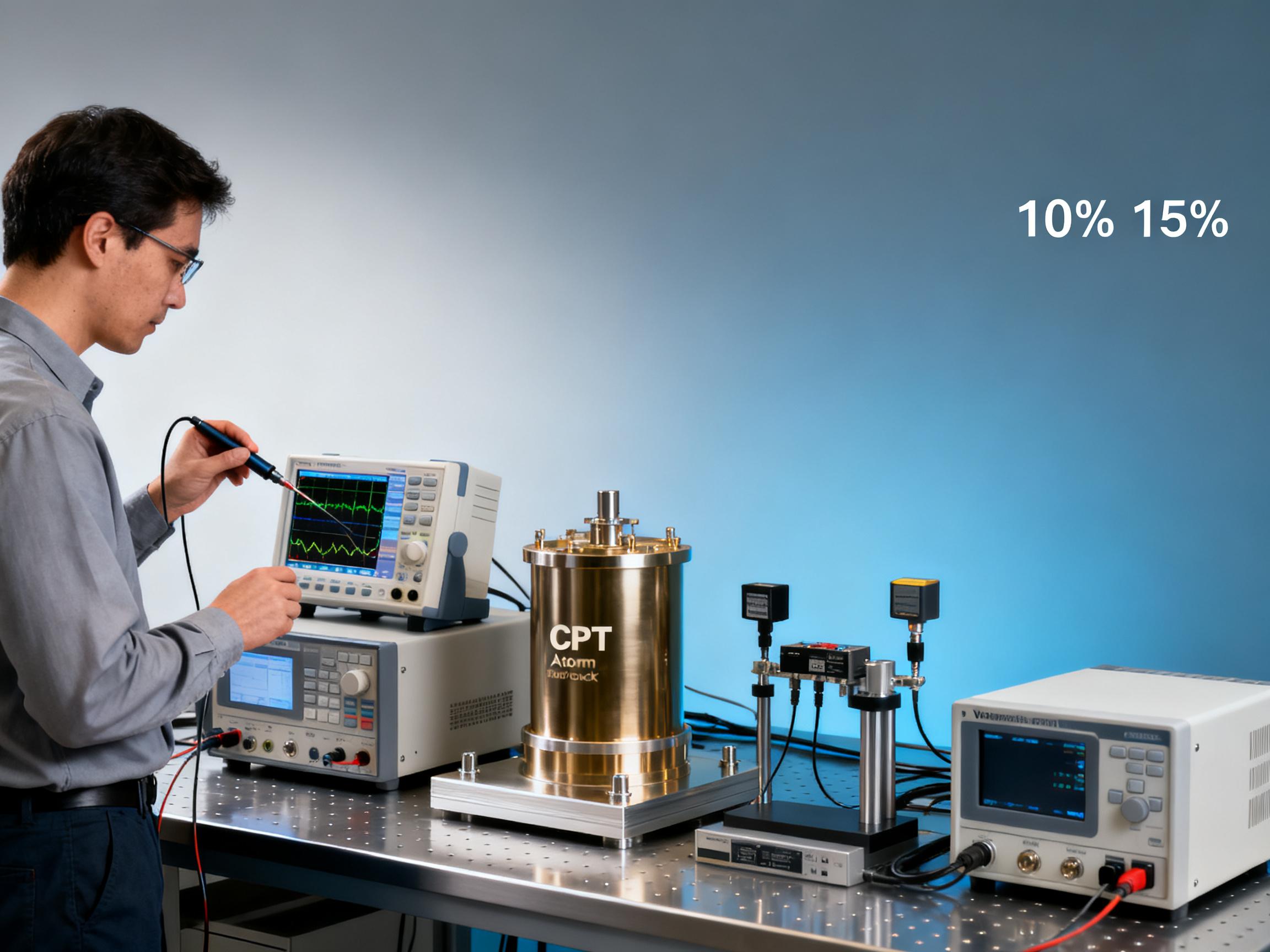RELATED
![How CPT Atomic Clocks Reduce OPEX in 5G Base Stations [Real Data] How CPT Atomic Clocks Reduce OPEX in 5G Base Stations [Real Data]](https://usimg.bjyyb.net/grey.png?x-oss-process=image/resize,m_fixed,w_800,h_600,limit_0) How CPT Atomic Clocks Reduce OPEX in 5G Base Stations [Real Data]2025-12-11
How CPT Atomic Clocks Reduce OPEX in 5G Base Stations [Real Data]2025-12-11 2024 CPT Atomic Clock vs Rubidium: Which Offers Better Stability for Telecom Networks?2025-12-08
2024 CPT Atomic Clock vs Rubidium: Which Offers Better Stability for Telecom Networks?2025-12-08 Live Demo Results: CPT Atomic Clock Performance Under Harsh Environmental Tests (Data Inside)2025-12-05
Live Demo Results: CPT Atomic Clock Performance Under Harsh Environmental Tests (Data Inside)2025-12-05 Budgeting for Precision: Total Cost of Ownership for a Rubidium Atomic Clock Over 5 Years2025-12-03
Budgeting for Precision: Total Cost of Ownership for a Rubidium Atomic Clock Over 5 Years2025-12-03
MESSAGE
Rubidium atomic clock vs GPS: Which is Best for Critical Timing?
For information researchers, hands-on operators, and enterprise decision-makers who depend on sub-microsecond accuracy, choosing between a Rubidium atomic clock and GPS timing is a mission-critical decision. This article compares real-world performance, long-term stability, power consumption, and vulnerability to interference to help you assess whether a RubidiumOscillator — or networked GPS timing — best fits your operational, maintenance, and security requirements. Learn how a Rubidium atomic clock can strengthen resilient space-time infrastructure and when GPS remains a practical, cost-effective option for your optical manufacturing applications.
Fundamentals: How a Rubidium atomic clock and GPS timing deliver synchronized time
Understanding the distinct technical principles behind a Rubidium atomic clock and GPS timing is essential when you design or maintain precision optical manufacturing systems. A Rubidium atomic clock uses the hyperfine transition frequency of rubidium atoms as a reference. In practice this means the device contains a vapor cell of rubidium atoms and an optical or microwave interrogation system that locks a quartz oscillator to the atomic resonance. The resulting Rubidium atomic clock provides a local, self-contained time and frequency reference, delivering excellent mid-term frequency stability and predictable aging characteristics. A commercial RubidiumOscillator typically integrates temperature compensation, aging correction, and monitoring telemetry to support industrial deployment.
By contrast, GPS timing derives time from distributed satellite clocks using GNSS signals. GPS receivers compute time of week and adjust local oscillators based on satellite signal timing and corrections. Networked GPS timing solutions are widely available and can provide precise absolute time tied to UTC, which is critical when multiple sites must share a common timebase. The GPS approach relies on receiving stable satellite signals and running algorithms that compensate for propagation delay, atmospheric effects, and receiver clock errors.
Key technical metrics differ between the two approaches. Short-term stability is commonly expressed with Allan deviation: Rubidium atomic clock devices often show superior Allan deviation in the 1s–10,000s range compared with inexpensive crystal oscillators. GPS disciplined oscillators (GPSDOs) yield excellent long-term accuracy tied to UTC but can be limited by transient satellite reception issues and multipath. For optical manufacturing tasks where phase noise, jitter, and deterministic timing matter—such as synchronized exposure, lidar timing, or interferometric metrology—the spectral purity and low phase noise of a Rubidium atomic clock or high-end RubidiumOscillator can materially improve performance.
From an operational view, a Rubidium atomic clock provides predictable holdover—maintaining acceptable time and frequency performance during loss of external references—while GPS timing usually requires either local holdover capability or external redundancy to bridge outages. When your assembly lines, test benches, or distributed sensor systems are geographically constrained (inside shielded rooms or underground facilities), GPS reception may be unavailable or unreliable; in such cases, a RubidiumOscillator becomes a practical on-premise time source. Conversely, if absolute synchronization to global time and ease of deployment are top priorities, GPS timing often delivers a lower initial cost and simpler rollout, provided vulnerability to interference is mitigated.
Performance under real-world conditions: stability, holdover, and interference resilience
Performance considerations for a Rubidium atomic clock versus GPS timing extend beyond datasheet numbers into environmental robustness, interference susceptibility, and maintainability. In optical manufacturing environments, thermal cycles, EMI, and localized vibration can degrade timing performance if the reference oscillator is not designed for the conditions. A Rubidium atomic clock typically includes active thermal stabilization and engineered enclosure designs to maintain the atomic interrogation environment. This provides consistent mid-term stability even as ambient conditions fluctuate. Modern RubidiumOscillator modules also incorporate diagnostics that report lock confidence, local oscillator drift, and other telemetry useful for predictive maintenance.
Holdover capability critically differentiates solutions. When GPS is available, a GPSDO can discipline a local oscillator to match UTC extremely well; however, when satellite signals are lost due to jamming, shielding, or multipath, the GPS receiver loses its external reference and the system must rely on the local oscillator’s stability. Unless the local oscillator is a high-quality atomic device, time can drift quickly beyond acceptable bounds. A Rubidium atomic clock inherently provides holdover measured in hours to days at sub-microsecond or low-microsecond levels, depending on the model and its aging profile. For facilities requiring sustained accuracy during planned maintenance or unexpected signal loss, a RubidiumOscillator ensures continuity without complex network fallback strategies.
Interference and cybersecurity considerations are increasingly important. GPS signals are weak at ground level and vulnerable to jamming or spoofing. For mission-critical processes, that vulnerability represents a material risk: production lines that rely solely on GPS timing can suffer synchronization errors when signals are disrupted intentionally or accidentally. A Rubidium atomic clock is immune to RF jamming because it does not depend on external satellite signals; its isolation reduces an attack surface and improves operational resilience. Many industrial practitioners deploy hybrid architectures—Rubidium atomic clock(s) as the primary reference with GPS or PTP as a secondary synchronization input—so systems can both align with UTC when available and maintain robust local timing when external references are compromised.
Power consumption and lifecycle must also be evaluated. Rubidium devices require modest continuous power to sustain the atomic reference and thermal control, but their power usage has declined with modern designs. For systems where low power is essential, evaluate the specific RubidiumOscillator model's SWaP metrics. Maintenance intervals for Rubidium atomic clock modules are generally longer than for high-stability oven-controlled crystal oscillators, but periodic recalibration and end-of-life planning (cell aging, lamp or component degradation depending on architecture) should be part of asset management. For GPS systems, maintenance often centers on antenna integrity, grounding, and software updates to protect against vulnerabilities.
Deployment, integration, and total cost of ownership for optical manufacturing
Selecting between a Rubidium atomic clock and GPS timing for an optical manufacturing operation requires a pragmatic cost-benefit analysis that accounts for integration complexity, operational constraints, and long-term total cost of ownership (TCO). From an integration standpoint, Rubidium devices offer well-defined interfaces—10 MHz, 1 PPS, and Ethernet-enabled health telemetry—and can be rack-mounted or embedded depending on space constraints. The RubidiumOscillator can be paired with distribution amplifiers or time servers to deliver synchronized signals across production floors. For manufacturers running multiple test stations, using a local Rubidium reference reduces network timing jitter and eliminates dependence on centralized distribution that could introduce latency and single points of failure.
GPS-based timing excels when you need absolute UTC alignment across widely distributed facilities without deploying local atomic references at each site. For distributed networks across cities or countries, network-synchronized GPS timing combined with disciplined PTP (Precision Time Protocol) can be a cost-effective approach. However, the TCO calculation must consider mitigation for signal loss, such as backup RubidiumOscillator units, redundant antennas, or indoor reference distribution in shielded environments. In many optical manufacturing use cases, a hybrid strategy—deploying a primary on-site Rubidium atomic clock and maintaining a GPS feed for absolute time references and UTC reconciliation—provides the best balance of accuracy, resilience, and cost control.
When evaluating procurement, consider lifecycle costs beyond purchase price: service contracts, calibration, software/firmware maintenance, and spare parts. Rubidium atomic clock vendors typically offer multi-year support and predictive health reporting that reduces unexpected downtime. For enterprise decision-makers, performing a risk-weighted ROI analysis that quantifies the cost of production errors, rework, or downtime attributable to timing failures will often justify the premium for a RubidiumOscillator. Operators should also validate integration with existing control systems, verify available telemetry for condition monitoring, and ensure that the chosen timing solution complies with industry standards and traceability requirements.
Finally, plan for redundancy and operational procedures. Best practices include automated switchover between primary and backup references, routine verification tests of holdover performance, and a formal incident response plan for suspected spoofing or jamming events. Training operators on alarm thresholds and standard operating procedures will minimize human error and accelerate recovery. In many cases, a Rubidium atomic clock installed as the facility’s primary, with GPS as an auxiliary reference, achieves the highest operational availability for precision optical manufacturing.
Summary and recommended next steps
Choosing between a Rubidium atomic clock and GPS timing hinges on your operational priorities. If your optical manufacturing processes require robust, predictable holdover, low phase noise, and resilience to interference, a Rubidium atomic clock or RubidiumOscillator is the pragmatic foundation for resilient space-time infrastructure. If your priority is low initial cost and straightforward UTC alignment across distributed sites with reliable satellite reception, GPS timing can be a practical option when paired with mitigation measures for signal loss.
For enterprise decision-makers and operators preparing a procurement roadmap: evaluate the marginal cost of downtime related to timing, test candidate Rubidium and GPS solutions under representative environmental conditions, and consider hybrid deployments that combine the strengths of both approaches. Specify clear monitoring, redundancy, and maintenance plans to ensure predictable long-term performance.
To explore how a RubidiumOscillator or integrated timing system can be tailored to your optical manufacturing application, request a technical consultation or an on-site timing assessment. Our team can provide unit-level performance data, deployment blueprints, and a TCO model to support informed decision-making.
Action: Contact our sales engineering team to schedule a technical evaluation, request performance datasheets for Rubidium atomic clock models, or arrange a site timing resilience audit.
CONTACT US
Please use the form below to get in touch.
If you need a reply we will get in touch as soon as possible.

![How CPT Atomic Clocks Reduce OPEX in 5G Base Stations [Real Data] How CPT Atomic Clocks Reduce OPEX in 5G Base Stations [Real Data]](https://usimg.bjyyb.net/sites/91500/91958/1765179857856560163985903616.jpeg)



